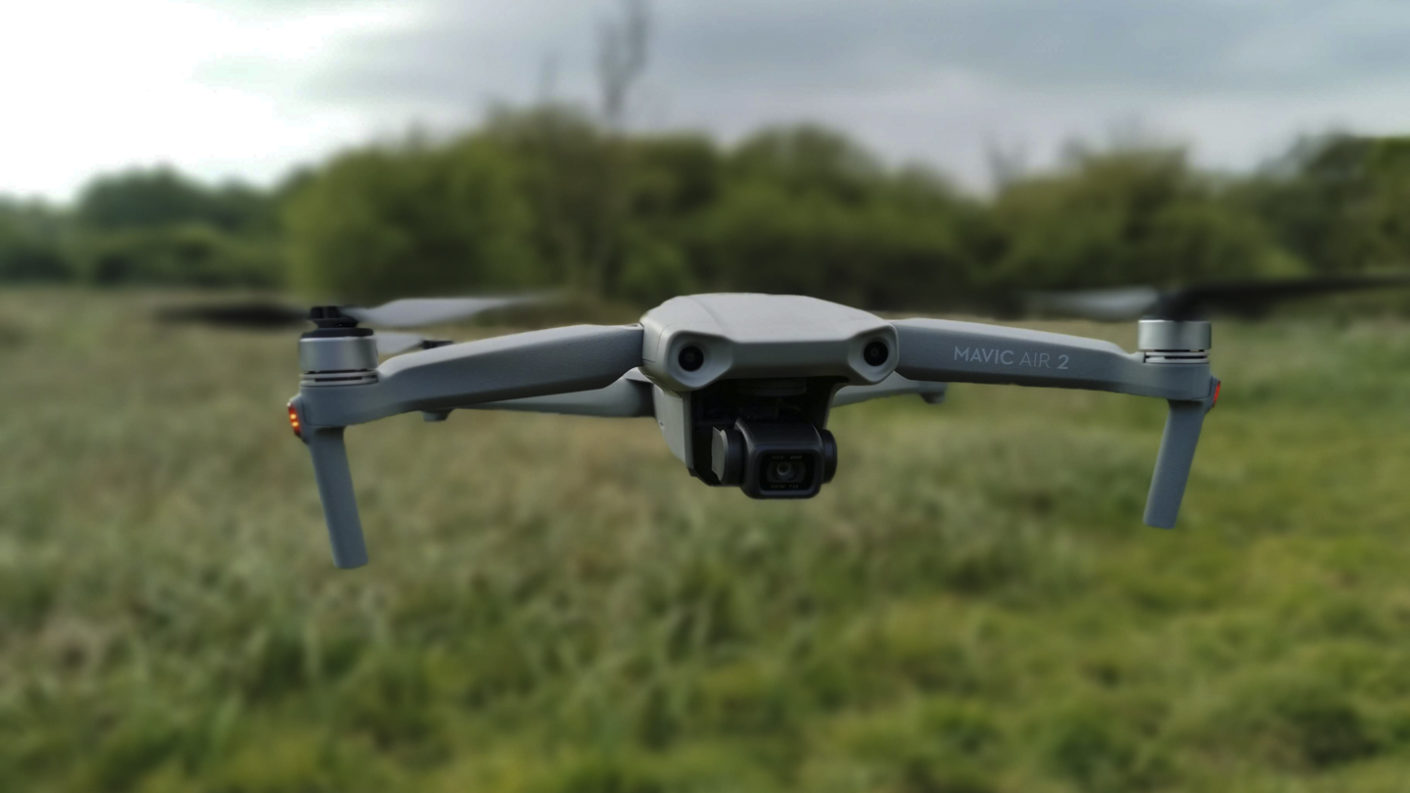Our Verdict
The DJI Mavic Air 2 sits between the ultra-lightweight Mavic Mini and the professional Mavic Pro. The Mavic Air 2 is a drone designed for the enthusiast photographer and videographer with a high-resolution camera that enables the capture of images at a. quality that far surpasses the previous generation. As ever flight and control are solid and the new handset design is a huge leap forward. If you looking for an imaging drone and don’t want to stretch to the Mavic Pro then the Air 2 is an ideal choice.
For
- Compact size and lightweight
- Long flight time
- High resolution camera
Against
- Flight restrictions increasing globaly
- Doesn't meet new flight drone flight regs
What is the DJI Mavic Air 2
The original Mavic was small, but then in 2018 the Mavic Air arrived, and it was even smaller and lighter. The Air was truly a compact ultra-portable drone with foldable arms designed to easily pack into a backpack so it could be taken anywhere.
The DJI Mavic Air 2 is the latest incarnation, and it’s not just a tweak of the old model, this is, after all, DJI, it’s a complete reworking.
A new, more robust and aerodynamic design, better camera, boosted flight features and a handset that feels a world apart from the old slightly flimsy offering, the Mavic Air 2 is 100% DJI quality.
But who is this new drone aimed at? Looking through the features it’s obvious that this a drone for the imaging enthusiast, someone who wants to capture stunning landscape scenery and make the most of aerial photography and film without spending a fortune.
Welcome to the Camera Jabber DJI Mavic Air 2 review
DJI Mavic Air 2 introduction
The original Mavic Air was small, well priced and found popularity with many photographers. Even now a couple of years after it’s launch it’s still a decent drone and perfectly capable of capturing stunning video and stills.
Because the old Mavic Air was so good the Air 2 has to be something special and to be honest, it is. DJI has gone back to the drawing board, and taken everything that was outstanding about the Air and other Mavic drones and developed the Air 2.
It’s slightly more substantial than the original, and the design while essentially Mavic is different from the original Air, it’s an entirely new drone that shares the name and a roughly similar look.
The reworked Air 2 sees an increase in specifications in almost every way compared with the original, more features, smarter, and a camera that’s capable of shooting high resolution and quality video and stills.
Specification
- Sensor Size: 1/2-inch
- Lens focal length: 24mm
- Lens aperture: f/2.8
- Video resolution and framerate: 4K 60fps
- Sensitivity range: Stills (12Mp): ISO 100-6400, Video: ISO 100-6400
- Slow motion: 1080p 8x 240fps
- Max bit rate: 120Mbps
- Stills resolution: 12 and 48Mp
- Max Speed: 19m/s
- Flight time: 34 minutes
- Size unfolded: 183 x 253 x 77mm
- Weight: 570g
Features
Each of DJI’s drone ranges is distinctive in style, and design, and the Air 2 is no exception. Instantly there’s no doubt that this new drone is from the Mavic line-up.
The overall size is compact at 180 x 97 x 84mm folded and once two rear arms are unfolded, and the front arms swung out the drone measures 183 x 253 x 77mm.
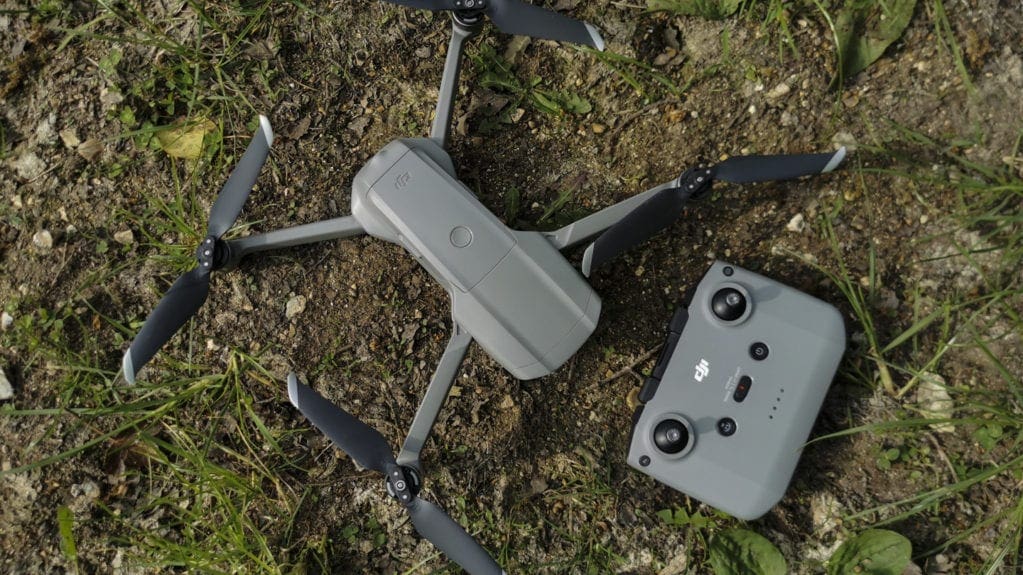
Looking over the body of the drone and you can see a series of sensors; two on the front, two on the back and four, plus an LED on the base to enable better landing in all conditions.
Partnering the small size is the lightweight at 570g, slightly more substantial than its predecessor, but then you do get an extra 13 minutes of flight at 34 minutes.
The battery is an 11.55v, 3500mAh lithium ion unit and it can be quickly swapped in and out as power is required. The handset features a built-in rechargeable battery and the drone and handset battery can be charged at the same time.
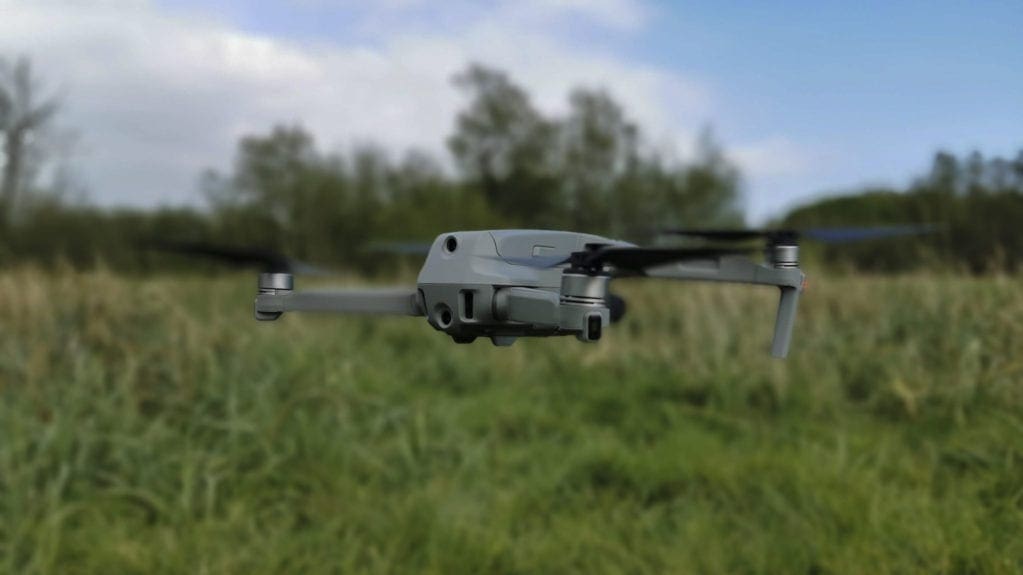
Despite the small size, or maybe because of it, the Air 2 has a maximum speed of 19m/s in sport mode, 12m/s in normal mode and 5m/s in tripod mode. All three modes are readily accessible on the remote control.
The max distance away from the operator that the drone can fly is 10km, although doing so in the UK would be breaking all drone safe rule so should not be tested.
The drone also has GPS and Glonass built-in, which helps with the flight control and smart features.
DJI Mavic Air 2 Camera
The camera is, of course, the area of most interest for us as photographers. DJI has worked at existing imaging and flight features that have appeared on previous drones and incorporated these into the DJI Fly App.
The first of these features is FocusTrack and has three options: ActiveTrack 3.0, Point of Interest 3.0 and Spotlight 2.0.
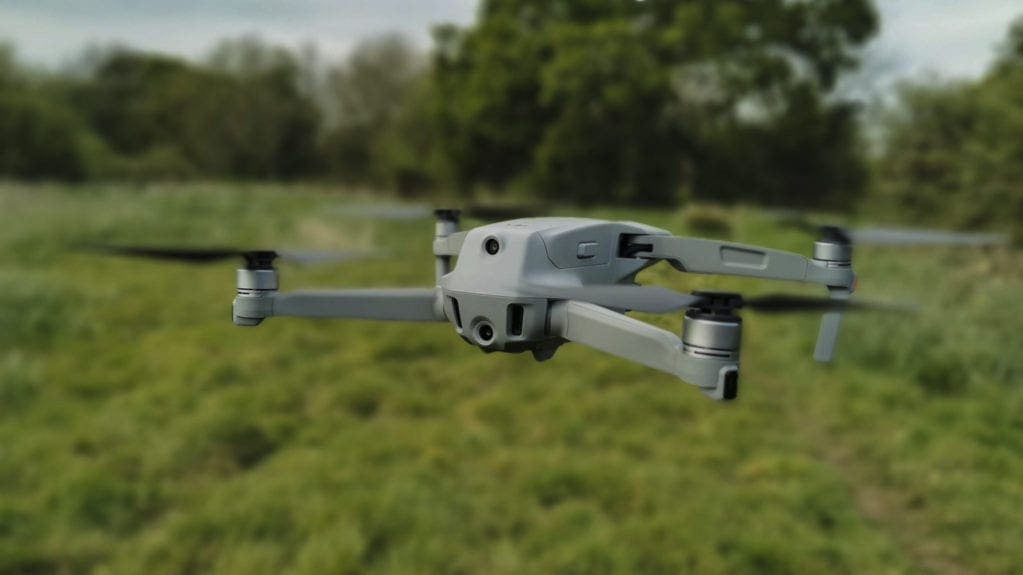
ActiveTrack has advanced a long way since the original feature was developed. ActiveTrack 3.0 essentially enables you to get the DJI Air 2 to lock onto a subject and follow it. This is ideal, for example, if you want to capture mountain bikers. Locking on to the subject enables the drone to do the hard work of keeping the subject in the frame. This latest version expands on the smart side of the feature and can now reengage a subject even if they disappear briefly from the drone’s line of sight.
Point of Interest 3.0 enables you to set the drone of a path to film an object along an automated path. This allows you to capture cinematic style shots with ease quickly.
Spotlight 2.0 filters down from DJI’s professional series drones and locks the camera onto a subject while you still have total control over the drone.
All three features enable you to capture stunning video sequences out of the box and without years of flight training.
To capture all this footage, the camera is mounted on a 3-axis gimbal; this takes out all the shake and wobble created by flight to enable the capture of smooth professional-looking video.
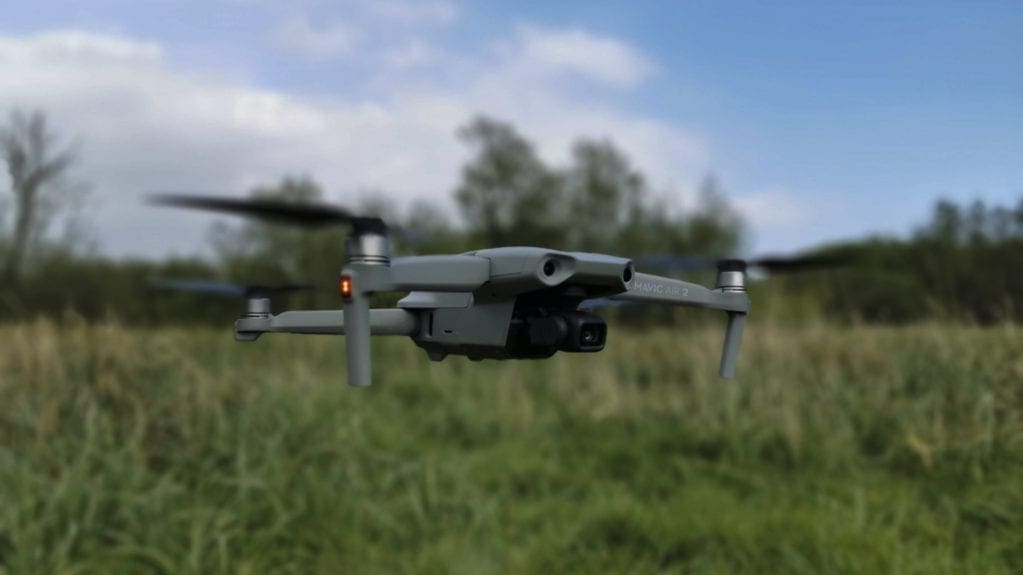
The camera itself features a 1/2-inch CMOS which is large for a camera of this size. This enables you to capture stills at 12mp and a new ultra-high-resolution 48mp.
When switched to manual, ISO can be selected for stills between 100 – 6400 or 1000-3200 for high resolution and can be captured as JPEG or RAW.
The shutter speed range is also impressive with a range of between 8 seconds and 1/8000.
The compact lens is rated at a focal length of 24mm which is ideal for aerial work.
This lens features a fixed f/2.8 aperture. For aerial work, you don’t have to worry too much about depth-of-field, but light can be a real issue. However, ND filters are very likely to be announced.
The video options are another prominent feature with 4K at 60fps and 1080p at up to 240fps for ultra-slow motion. All this footage can be captured at 120mbps.
DJI Mavic Air 2 Controller
Another significant change over the previous version is the controller. The old one never matched the quality and usability of the drone itself; however, the new controller is spot-on.
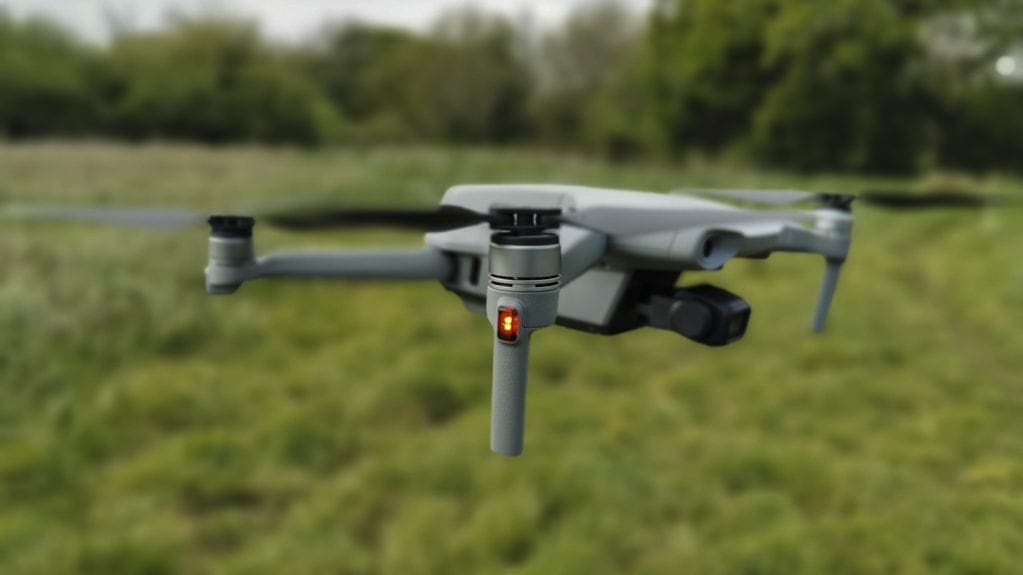
It’s simple in design, with the two joysticks, return to home, mode and power all on the front. These main buttons are joined by the camera mode and an Fn button.
On the top left is the jog dial that either adjusts the tilt of the gimbal or tapping the Fn button will cycle the camera through the aperture or exposure comp depending on which exposure mode you’re in.
On the right the photo or video shutter button, again the Camera mode button on the front enables you to switch between the two quickly.
Finally on the top is the phone holder, this pulls out and fits your phone snuggly. Something like a Huawei P30 Pro is a tight fit but does give you a decent display.
As ever the phone is plugged directly into the controller through USB Type-C or Lighting enabling ultrafast transmission for the live view stream from the drone to the handset.
The latest version of the Fly app is as streamline as ever, with clear setup and connection instructions as well as the ever-increasing flight checks and safety information.
In the US there will be the activation of the AirSense feature that warns you of the distance of aeroplanes and helicopters, but at present these are not implemented for the UK.
If you’re wondering about the new drone regs that were supposed to be implemented in July, then these have been delayed, possibly to November.
DJI has said that until clear guidance for manufacturers is set out, they can’t mark the drones with the correct markings but will look at this once laws and regulations have been passed.
At any rate, the drone will be fine to fly under the open category with the restrictions until at least June 2022.
Build and Handling
DJI products always have a certain DJI feel. The choice of plastics and other materials are still carefully considered to give a balance between weight and durability.
The grey coloured Air 2 is of plastic and metal construction which all feels good and robust.
The four fold-out props are thin but feel incredibly strong. There’s nothing to worry about when it comes to build quality, this is as good as it gets.
Set about flying for the first time requires some preparation of the drone and handset, but not a lot.
Preparing the Mavic Air 2
Starting the practical part of the DJI Mavic Air 2 review the drone and handset are removed from the packaging, then before the first flight, everything needs a good charge. Here a nice feature is that the charger enables both the handset and drone battery to be plugged in at the same time.
As the battery charges the drone can be prepared to start with the rear arms which are rotated out and these are followed by the front arms which fold out. Once done, the Air 2 looks more drone-like and the props can be attached.
The propellers simply slot and twist to clip in place, no screws, bolts or other devices, just nice quick and simple. Removing them is equally easy, push them down rotate, and away they come.
Next, you can pop in the charged battery, this clips into the top of the drone securely. With that done and all stickers removed and a MicroSD card inserted in the side the drone is ready.
The handset just requires the two metal sticks to be screwed in place. These are stored in two recesses on the base of the handset.
That done and the drones ready to be packed and taken to your take-off location.
Performance
Set-up and pre-flight checks are relatively quick. Pop your mobile into the clamp on top of the controller, switch on the handset which will automatically start the phone app, then power-up the drone.
The power-up process for handset and drone is the same, one quick press followed by a longer one.
A few beeps all-round and a successful boot and connection between handset and drone will be highlighted in the Apps camera view.
Before you can see the main App screen DJI Fly takes you through the pre-flight checks before settling on the main camera view.
DJI Fly App
This screen gives you quick access to all the drone and camera settings and shows a direct video feed from the drone’s camera to the smartphone.
The App screen will let you know if everything is OK to take off, and also highlights if you’re in a restricted or no-fly zone. The App will also set the home location automatically and pings to highlight that it has done this.
The return to home feature is essential as if you lose control of the drone, which is unlikely, or more likely you lose all perception of what direction the drone is going, you can hit the return home on the handset and the drone will automatically fly back to you.
Another handset feature that I really like is the ability to switch between Sport, Normal and Tripod flight modes. These essentially change the speed of the craft and its reaction speed.
Normal is a good place to start if you’ve flown before, use Tripod if this is your first time. Sport is really for experienced flyers only and is great fun. For this test, normal flight mode is selected to start.
All pre-flight checks done and it’s time to take off, there are two ways to do this, either use sticks pulled down and towards the middle or use the on-screen auto take-off feature.
DJI Mavic Air 2 first flight
Take-off, either way, takes a few seconds and before too long the Air 2 is in the air. Instantly you can feel the difference between this and the Pro and Phantom, the extra weight of the two larger machines do make a difference to the stability and control accuracy, but this is still a formidable craft in the air.
Before giving the camera a check out I tested the flight control in order to familiarise myself with how this drone flys, it’s very DJI. solid and accurate. First up was to fly up to 20m and about 50m away from myself before hitting return home to see if everything was set correctly.
Sure enough, the Air 2 returned to base and settle back on the launch pad, a real 10 out of 10 for return home accuracy.
Next take off, still in Normal, and a quick lap of the field, then figure of eight and all looks good. Switch to Tripod mode and another lethargic trip around the field before switching to sport mode and running the craft as low to the ground as it would go without screeching warnings.
In sports mode, the Air 2 feels more akin to the Mavic Pro 2 and less squidgy in flight than in Normal mode. The air brake especially seemed to really kick in with power whereas it seemed a bit underpowered in Normal mode.
General flight of the drone is good, you can’t get full manual flight as the drone is always GPS enabled, so there’s no loops or tricks but it’s a good solid flyer. At this point if you are looking for a drone just for fun, then go for the Mini, it’s far cheaper and flight wise much the same.
The DJI Mavic Air 2, however, is about the imaging.
DJI Mavic Air 2 photography
Before taking off it’s a good idea to get the shooting options set in the DJI fly App. Resolution and shutter speed, or just let the drone work it out for you.
You do get a good clear birds-eye view of what the drones see through the app, but in the UK at least, you are supposed to keep your eye on the drone at all times, so no glancing down at the screen to see what you’ve got or fiddling with the settings.
On the handset, switch to fly in Normal mode, and use this to fly the drone into position, then switch to tripod mode. This slows the drone right down and enables you to compose your shot. I find looking up at the drone with the handset lifted enables you to keep an eye on the drone while being able to see the screen.
Alternatively, a far better idea is to have someone with you who can worry about the composition of the image while they direct you as to how to manoeuvre the drone. Using Tripod mode for this is ideal.
Once you have your drone in the right place and the camera is positioned, you can tilt it up and down using the wheel by your left index finger, then you’re ready to take the shot. On the top right of the handset, there’s the shutter button, a quick press and the image is captured.
It doesn’t matter the about the camera mode you’re in, all adjustments to exposure, shot type, standard or HDR and resolution can be made through the app. Again either get those settings right before takeoff or have someone with you who can adjust the settings.
DJI Mavic Air 2 image quality
DJI really know their stuff when it comes to aerial imagery and the quality of the still images are of incredible quality. The clarity, colour and detail is outstanding and no doubt due to the quality of the small Osmo style camera with 1/2-inch sensor on the front.
At 12mp and 48mp the physical size of the files is obvious, but viewing the files at 100% and moving around shows the depth of quality. There is really very little to fault from the 24mm f/2.8.
DJI Mavic Air 2 Videography
There’s no doubt that the small Air 2 takes outstanding images, and these are matched by equally impressive video.
The ability to adjust the resolutions and framerates gives you plenty of scope, and the camera seemed to deal well with the exposure on a bright late spring, early summers day.
Other parts of the world do get a bit brighter than here in the UK, and the conditions of the environment have an obvious effect on the exposure, so may require filters. Here, however, I was very pleased with the overall look and quality of the footage.
What really drives the DJI drones are those additional smart features, and here the ActiveTrack once again works to outstanding effect. Locking on target and taking a backward stroll across the field and the small drone follows sedately along.
Switching to someone running across the field and again the ActiveTrack works well, although I was unable to test to see if the drone could pick up the trail of the subject if they did go out of sight.
The object avoidance sensors also did their thing, navigating around obstacles such as trees and even foliage that gets in the way, although it does this with a load warning beep.
Flying and filming manually and the drone works exceptionally well, but with only tilt control on the camera the adjustments are limited. But then there’s SpotLight.
Spotlight is a feature that has appeared on the professional Inspire drones and enables you to lock the camera on target and then fly manually. The effect is impressive although the cameras gimbal is limited on the amount of free movement it has, but still for a drone of this size and price the feature is impressive.
DJI Mavic Air 2 Video quality
Having looked at most of the previous DJI drones I’m aware that the company takes image quality very seriously and that’s true here with the Air 2.
The footage quality from 4k 60fps to 1080p 240fps is excellent. I don’t think that any videographer would argue with the balance of small drone and price.
As the framerate rises at 1080p the footage does start to the loose definition and you need to ensure you have good light, but still, the footage looks good and gives you greater creative flexibility.
Looking at 4K 30fps and 1080p 30fps and the quality is superb, once again the technology involved with the small gimbal is outstanding. The footage looks smooth and fluid and it’s hard to believe that it’s been captured on such a small craft.
DJI Mavic Air 2 Sample Video
The video below was shot on the DJI Mavic Air 2 in 4K 30P. Most of the footage was shot in the standard modes, but FocusTrack is demonstrated in Spotlight mode and there’s a section of HDR Video with a comparison clip.
Verdict
During the test, I’ve been impressed with the quality of this small drone. The build quality is outstanding and the new handset now meets the design and quality of the drone itself.
Improvements to the Fly app make flying the drone even safer and further enhancements to the safety will hopefully be added after the global COVID lockdown ends.
When I first started the DJI Mavic Air 2 review it was the image quality that I was most excited about. Having taken a look at the Mavic Pro 2 last year I’ve already seen what’s possible and while the Air 2 might not have the full range of features and all the cinematic modes, it has other features and boosted specifications that actually better the Pro.
The DJI Mavic Air 2 imaging doesn’t disappoint with outstanding images and video. The huge 48mp stills resolution is impressive and enables you to capture truly stunning aerial shots.
Likewise, the inclusion of the professional SpotLight feature enables budding videographers the ability to capture complex drone sequences that would usually require highly skilled drone camera operators.
I’ve been impressed with the small drone and by the end of the DJI Mavic Air 2 review I’d say it’s an excellent choice for any enthusiast wanting to capture aerial shots.
I hold back on suggesting this for professional work due to the size, I feel that you need something with a little more flexibility with the flight and camera, but that’s not to say the quality of the camera isn’t up to professional work.
The big professional reservation is due to the incoming regulations, but as no one truly knows all the ins and outs, features and markings we can but speculate.
For now the DJI Mavic Air 2 is a fantastic drone that’s able to capture superb images and video.

